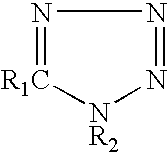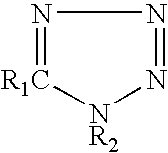Soldering Flux
- Summary
- Abstract
- Description
- Claims
- Application Information
AI Technical Summary
Benefits of technology
Problems solved by technology
Method used
Image
Examples
example 1
[0027]Post fluxes having the compositions shown in Table 1 were prepared, and their corrosive properties on a copper plate and wettability were compared with those of comparative examples. The wettability of a flux was evaluated using a solder spreading test. The results are shown in Table 1.
TABLE 1ExamplesComp. Examples123456789101234FluxPolymerized1010101010101010101010101010componentrosinDiphenyl-0.50.50.50.50.50.50.50.50.50.50.50.50.50.5guanidine-HBrAdipic acid222222Dimer acid222222222,3-dibromo-2-0.50.50.50.50.50.50.50.50.50.50.50.50.50.5butene-1,4-diol5-phenyl-0.050.250.050.25tetrazolePhenyltetrazole-0.25-thiolHydroxyphenyl-0.2tetrazole-5-thiol1H-tetrazole0.25-chloro-1-0.2phenyl tetrazoleBenzotriazole0.1Propyl gallate0.5IPAremremremremremremremremremremremremremremTestCopper plateΔ◯◯Δ◯◯◯◯◯◯XXX◯corrosion testSpreading ratio7675687675697575757576767658(%)1. Method of copper plate corrosion test (according to JIS Z 3197 8.4.1)1) A phosphorus deoxidized copper plate measuring 50 m...
example 2
[0029]Solder pastes having the compositions shown in Table 2 were prepared and compared with comparative examples by testing them by a copper mirror corrosion test. The results are shown in Table 2.
TABLE 2ExamplesComparative123456712FluxPolymerized rosin353535353535353535componentHydrogenated rosin14.9514.81014.814.814.814.81514.8Hardened castor oil5555555552-ethylhexyl diglycolremremremremremremremremremSebacic acid2222222222,3-dibromo-2-buten-3333333331,4-diol5-phenyltetrazole0.050.25Phenyltetrazole-5-0.2thiolHydroxyphenyl-0.2tetrazole-5-thiol1H-tetrazole0.25-chloro-1-phenyl-0.2tetrazolePropyl gallate0.2TestCopper mirror test◯◯◯◯◯◯◯XX1. Method of copper mirror corrosion test (according to JIS Z 3197 8.4.2)1) A flux for a solder paste is dissolved in 2-propanol to prepare a 25 mass % 2-propanol solution, which is used as a sample for measurement. Similarly, a WW rosin is dissolved in 2-propanol to prepare a 25 mass % 2-propanol solution of WW rosin as a comparative sample.2) The su...
PUM
| Property | Measurement | Unit |
|---|---|---|
| Percent by mass | aaaaa | aaaaa |
| Mass | aaaaa | aaaaa |
Abstract
Description
Claims
Application Information
 Login to View More
Login to View More - R&D
- Intellectual Property
- Life Sciences
- Materials
- Tech Scout
- Unparalleled Data Quality
- Higher Quality Content
- 60% Fewer Hallucinations
Browse by: Latest US Patents, China's latest patents, Technical Efficacy Thesaurus, Application Domain, Technology Topic, Popular Technical Reports.
© 2025 PatSnap. All rights reserved.Legal|Privacy policy|Modern Slavery Act Transparency Statement|Sitemap|About US| Contact US: help@patsnap.com



